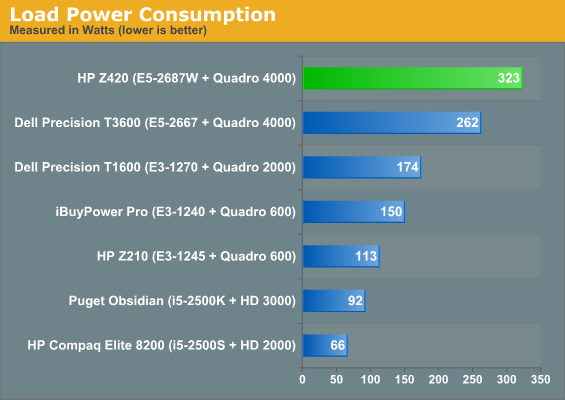HP Z420 Workstation Review: Competition Heats Up
by Dustin Sklavos on May 21, 2012 12:00 AM ESTBuild and Power Consumption
Where I think the HP Z420 winds up really losing step with the Dell Precision T3600 (and where HP's current workstation lineup loses step with Dell's pending update) is build quality. The Z420 isn't badly built, but not much seems to have changed in some time. It's easy to rest on your laurels when you're on top, and that seems to be the case with the...uh...case.
.jpg)
The side panel pops off via a quick-release lever, and most of the individual parts are accessible via internal quick-release levers. Our Xeon is also cooled with a custom liquid-cooling solution (required with this upgrade), but HP sticks with an 80mm fan instead of moving up to a potentially more powerful (and quieter) 120mm fan, wasting some of the radiator surface area.
I personally prefer the internal layout of Dell's Precision T3600, with its easily swappable power supply and just generally cleaner interior design, but where HP wins and Dell loses out is memory capacity: the Z420 sports the full eight DIMM slots that Sandy Bridge-EP supports, while the T3600 is forced to make do with just four.
Unfortunately for HP, Dell's system looks better and is ultimately easier to service. The best thing HP has to compete with the sturdy aluminum handles built into the Dell chassis is a $30 upgrade to a service handle that occupies the top optical bay. Clearly the money is in enterprise, but a $30 handle is the kind of thing you expect to see on a government expense report.


HP's system is also a lot less efficient than Dell's under load. The idle difference isn't major and can probably be chalked up to the extra pair of hard drives in Dell's build. Unfortunately, under load the extra 20 watts off of the processor, the closed-loop liquid cooler, and the four extra DIMMs all seem to take their pound of flesh. I have a hard time believing that accounts for a full sixty watts of power; HP may need to go back and tinker with their power supply.


_thumb.jpg)
_thumb.jpg)
_thumb.jpg)
_thumb.jpg)
_thumb.jpg)








35 Comments
View All Comments
satai - Monday, May 21, 2012 - link
How do Dell and HP offerings compare related to noise? Does anybody offer an ULN workstation with enough horsepower?Dustin Sklavos - Monday, May 21, 2012 - link
I can't give you definitive noise figures, but I can tell you the Precision was noticeably quieter than the HP. The T3600 was very quiet, while the Z420 was noticeable. Not LOUD, but definitely audible.satai - Monday, May 21, 2012 - link
Thanks. That helps me a much.ectoplasmosis - Monday, May 21, 2012 - link
Why on earth would you not test noise as part of the review? Not what I'd expect form Anandtech.thewhat - Monday, May 21, 2012 - link
The case, layout and cooling seem very generic. At this price point I'd expect something better.It seems that quiet builds are never a priority with big companies like HP and Dell.
piroroadkill - Monday, May 21, 2012 - link
In my experience Dells have always been pretty good in this area, they were the first to adopt BTX style cases with CPUs at the front with nice intakes (if not the first, they must be close!) and always have nice extensive cowling, temperature adaptive fans, and generally are nice to service.Taft12 - Monday, May 21, 2012 - link
Fully agree with you there - I've found Dell desktops to always be whisper quiet compared to any PC assembled from parts unless special care has been taken to choose parts geared for silencemapesdhs - Tuesday, May 22, 2012 - link
Very true, I have a Dell T7500 (dual XEON X5570), it's extremely quiet. It makes so little
noise, sometimes I forget it's turned on.
Ian.
behold4r - Monday, May 21, 2012 - link
I would like to ask something very specific. I know that many of you might find this a joke, but still I would like to know, because I haven't had the opportunity to own such a machine myself but I am in the process of researching such an option.I would like to ask if you could overclock the Xeons (the E5-2687W for example on this system) in order to take them up to 4.0GHz , just like an intel 3960 cpu can. Is there such an option in the BIOS (whether it is on the HP machine or with some other motherboard you've seen)
That would it make very attractive for rendering or fluid simulation (more bang for your buck, and since we are talking about ~1.900$ these are a lot of money for a single cpu)
And one other thing, would it be possible in your tests of server cpus (xeons or opterons) to include any fluid simulation test, in particular with RealFlow as well as any rendering tests with a real scene (meaning not just cinebench but rendering a maya scene in mental ray, and I am not talking about prefabed tests like specviewperf)
fic2 - Monday, May 21, 2012 - link
I don't know about this system, but in general large PC companies such as HP and Dell do not leave any overclocking options in their bios.For that you are generally better off either building your own, going with a small PC builder or going with one of the companies that specializes in high end overclocked systems.